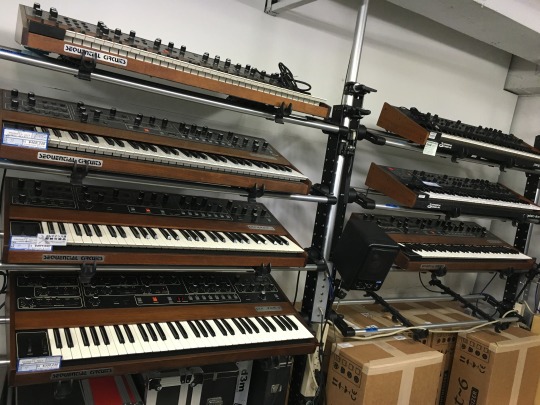If you got an Elektron Analog Four (or Analog Keys) and devices that can be operated via CV (control voltage) and Gate trigger connections, here’s how to do it, e.g. connect Moog Minitaur and Arturia MiniBrute to sequence, automate and processes them on Analog Four.
1. Connect a stereo ¼” (female) to CV Output A and B on Analog Four, and dual mono ¼” to Pitch CV (tip) and Gate (ring) of the Minitaur.
2. Connect Audio Out on Minitaur to Audio Input Left on Analog Four.
3. On Analog Four, select track Trk 1.
4. Select Osc 1 > IN L.
5. Pass all frequencies on 2-pole ladder filter: Filters > FRQ 127 and RES 0, and 2-pole multi mode filter: Filters > HP2 > FRQ 0 and RES 0.
6. Set the envelope on Amp > REL INF (if you don’t plan to use the Osc 2, sub oscillators or filter self-oscillation of the Analog Four).
7. Select track CV.
8. Set CV > CV A > TRK > TR1 and CV > CV B > TRK > TR1.
9. Select CV A configuration page, and set:
TYPE > PITCH V/oct
NOTE 1 > C 3
VOLTAGE 1 > 1.448 V
NOTE 2 > C 6
Voltage 1 > 4.634 V
10. Select CV B configuration page, and set:
TYPE > GATE
POLARITY > V-TRIG
LEVEL > 5.0 V
11. Connect a stereo ¼” (female) to CV Output C and D on Analog Four, and dual mono ¼” to Pitch (to VCO) (tip) and Gate In (ring) of the MiniBrute.
12. Connect Master Out on MiniBrute to Audio Input Right on Analog Four.
13. On Analog Four, select track Trk 2.
14. Select Osc 1 > IN R.
15. Pass all frequencies on 2-pole ladder filter: Filters > FRQ 127 and RES 0, and 2-pole multi mode filter: Filters > HP2 > FRQ 0 and RES 0.
16. Set the envelope on Amp > REL INF (if you don’t plan to use the Osc 2, sub oscillators or filter self-oscillation of the Analog Four).
17. Select track CV.
18. Set CV > CV C > TRK > TR2 and CV > CV D > TRK > TR2.
19. Select CV A configuration page, and set:
TYPE > PITCH V/oct
NOTE 1 > C 5
VOLTAGE 1 > 1.004 V
NOTE 2 > C 8
Voltage 1 > 4.004 V
20. Select CV D configuration page, and set:
TYPE > GATE
POLARITY > V-TRIG
LEVEL > 5.0 V
Set up the old king SH-101
If you got a Roland SH-101, the set it up like this:
1. Connect a stereo ¼” (female) to CV Output A and B on Analog Four, and dual mono ¼” to CV In (tip) and Gate In (ring) of the SH-101.
2. Connect Output on SH-101 to Audio Input Left on Analog Four.
3. On Analog Four, select track Trk 1.
4. Select Osc 1 > IN L.
5. Pass all frequencies on 2-pole ladder filter: Filters > FRQ 127 and RES 0, and 2-pole multi mode filter: Filters > HP2 > FRQ 0 and RES 0.
6. Set the envelope on Amp > REL INF (if you don’t plan to use the Osc 2, sub oscillators or filter self-oscillation of the Analog Four).
7. Select track CV.
8. Set CV > CV A > TRK > TR1 and CV > CV B > TRK > TR1.
9. Select CV A configuration page, and set:
TYPE > PITCH V/oct
NOTE 1 > C 3
VOLTAGE 1 > 0.986 V
NOTE 2 > C 6
Voltage 1 > 3.956 V
10. Select CV B configuration page, and set:
TYPE > GATE
POLARITY > V-TRIG
LEVEL > 5.0 V
Note that the voltage levels are roughly set. Also bear in mind that it seems that some split cables use left for tip and right for ring, while others directly contrary.
Tune Other Gear
If you got other gear, then connect a tuner to the audio output, select CV A configuration page and start with:
TYPE > PITCH V/oct
NOTE 1 > C 3
VOLTAGE 1 > 1.000 V
NOTE 2 > C 6
Voltage 1 > 4.000 V
Then just tweak the voltage settings – 1 V per octave in the mid range – according to the tuner, this usually works.
Lastly, don’t forget to check all four voices on the KIT > POLY CONFIG > VOICES to use Analog Four as an analog polysynth while using the two external sound sources of your choice.
P.S. I totally missed this, but this blog, Holy Bot, turns four years today, yay!


